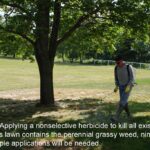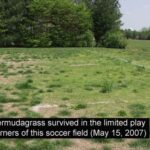Category: Maintaining a Home Lawn
September is Crucial for Fertilizing All Cool-Season Turfs
With the returning rains in the state, now is the most important time to fertilize cool-season turfgrasses like creeping bentgrass, Kentucky bluegrass, perennial ryegrass, and tall or fine fescue. September fertilization is crucial on all turf areas regardless if it is a lawn, athletic field, or golf course green, tee or fairway. Fertilization in mid-September […]
Rejuvenating Turf Areas After Drought
Eight weeks or more of high temperatures with minimal rain has taken a toll on turfgrasses around the state. Though some local areas in central IN have received ample rain in the last week, many areas are still very dry. We are just entering the window when significant turf recovery can be encouraged. Reseeding is […]
How much perennial ryegrass Kentucky bluegrass in a mix?
With the renovation season fast-approaching, questions abound about how much perennial ryegrass to use in a P. rye/K. bluegrass mix. Perennial ryegrass germinates quickly and provides quick cover and soil stabilization when used in a blend. However, too much perennial ryegrass leads to long-term problems from dollar spot, brown patch, red thread, and other diseases. […]
Now is the Time to Start Improving Your Lawn
Tired of the way your lawn looks? If it hasn’t looked up to par this summer reseeding your lawn is an option. Mid-August is the best time to seed a new lawn or overseed an existing lawn, but planning should start now. If the lawn is just thin and needs a little help, fall is […]
White Clover in Golf Courses, Sports Turf, and Lawns
The small white flowers of white clover are very visible right now and it may appear that clover is taking over, especially under-fertilized turf areas. Clover is a legume and is very competitive under low N conditions, so increasing annual N is the best method for long-term control. The temptation is to apply a herbicide […]
Lawn blemishes exposed by drought
Maintaining lawns and other turf areas is fairly straightforward in the cool and wet weather of the spring and fall, but things get tougher once the heat and drought set in. We are currently seeing a wide variety of problems, all of which are enhanced by the dry conditions. Problems that we are seeing include: […]
Don’t raise the mowing height during drought
Typical advice in the paper and TV is to raise the mowing height during drought to help the turf area stay green. However, this is very simplified advice which needs clarification. Here are some well-researched facts: • The higher you mow a grass plant, the deeper the roots. • Deeper roots mean a larger reservoir […]
Facts and Advice on Turf Survival in Drought
There are many questions about turf survival in drought with the on-going drought in most parts of the state. Though we understand many of the mechanisms turf survival in drought, it’s hard to duplicate all of the potential situations on research plots across the country and it’s difficult to give definite “black and white” recommendations […]
Winter damage on bermudagrass
As bermudagrass begins to green up in southern IN and Kentucky , it is apparent that moderate to severe winter damage has occurred. Though we may be a little premature because full green-up and growth is still a week or two away depending on temperatures, it’s important to start formulating a strategy to repair the […]
Brown Tracks in Lawn
With the mild drought stress over the last week, lawns are extremely susceptible to cosmetic damage from mowers, spreaders, and human traffic (photos). Drought stress may not have been easily visible before mowing. Turf likely was at the drought stressed stage where footprints (or mower tracks) remain in the turf and don’t snap back like […]
Late May is Good Time to Fertilize Lawns
The annual phase of rapid cool-season shoot growth of cool-season grasses is nearly complete, though it was diminished this year because of the dry and cool weather. It’s now time to consider fertilizing your lawn because fertilizer now will not dramatically increase vertical growth as long as moderate nitrogen rates are used and it will […]
Seedheads Make for Tough Mowing
With the bizarre weather this spring, growth patterns of our cool-season grasses are inconsistent across the state. Kentucky bluegrass, tall fescue, and perennial ryegrass are either producing or soon will be producing seedheads. This natural phenomenon is induced primarily by daylength, but varies among species and cultivars. Seedheads detract from the appearance of a turf […]
Lawns turning brown overnight?
We have received a number of calls, email, and electronic photos inquiring about brown patches to entire lawns turning brown apparently overnight (see photos). Following are the three most likely culprits: • Seedheads – Especially on perennial ryegrass lawns, seed heads mowed by an even a marginally sharp blade will fray and turn brown as […]
Sand Topdressing Programs
There are many different sand topdressing programs used by superintendents. Budgets, experience, labor and equipment availability, and play schedule are just some of the factors affecting topdressing programs. Our research hopes to provide answers to many of the common topdressing questions and help present a better understanding of the topdressing requirements for high quality putting […]
Cold Weather Yellowing or Bleaching Newly Mowed Turf
Noticing yellow to white patches in areas that were freshly mowed just prior to last week’s cold? Judging from what I’ve seen as well as the emails, you’re not alone. Taking a closer look at these areas, the leaf tips and maybe the full length of the leaf has yellowed or even turned necrotic (dead) […]
Effect of cold snap on turf?
The recent cold snap should have little long term effect on the turf portion of the landscape. Our cool-season grasses are more than capable of withstanding weather like this, though newly emerged seedlings may suffer some damage from the cold and/or wind. Wind or desiccation damage may also be seen on fast growing tall fescue […]
Fire up the Mower!
Now’s the time to get the mower out of the shed and start mowing (depending on where you live in the state). This normally happens well before most of us start mowing because we see mostly brown leaf blades and we don’t think the lawn is growing. However, grass plants grow from the bottom up […]
Calculating the pounds of fertilizer to apply
There are literally thousands of fertilizers and fertilizer/pesticide combinations available to homeowners and professionals. Therefore, we can’t recommend how many pounds of a specific fertilizer to apply, but rather we must recommend fertilization rates in pounds of nitrogen per thousand square feet or lbs N/1000 sq ft. You can use our fertilizer calculator at http://www.agry.purdue.edu/turf/fertcalc/Fertilization%20calc.html or you […]
How much perennial ryegrass Kentucky bluegrass in a mix?
Perennial ryegrass germinates quickly and provides quick cover and soil stabilization when used in a blend. However, too much perennial ryegrass leads to long-term problems from dollar spot, brown patch, red thread, and other diseases. Kentucky bluegrass has better disease, drought, and wear tolerance the perennial ryegrass, but is very slow to germinate. Hence bluegrass […]
Keep mowing and don’t set the mower down
Many people ask how long to continue mowing into the fall. The answer is to keep mowing as long as the grass continues to grow which is normally into late October or early November. Frequency of mowing can decrease but continue to mow into the fall. Also avoid the urge to set the mower down […]







